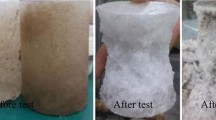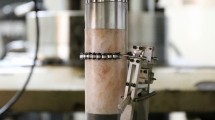Abstract
The fatigue test for rock salt is conducted to investigate the effects of stress amplitude, loading frequency and loading rate on the plastic strain energy, from which the evaluation rule of the plastic strain energy is analyzed, which is divided into three stages: cyclic hardening, saturation and cyclic softening. The total accumulated plastic strain energy only depends on the mechanical behavior of rock salt, but is immune to the loading conditions. A novel model for fatigue life prediction is proposed based on the invariance of the total plastic dissipation energy and the stability of the plastic energy per cycle.










Similar content being viewed by others
Change history
22 November 2018
In all the articles in Acta Mechanica Solida Sinica, Volume 31, Issues 1–4, the copyright is incorrectly displayed as “The Chinese Society of Theoretical and Applied Mechanics and Technology ” where it should be “The Chinese Society of Theoretical and Applied Mechanics”.
References
Liang WG, Zhao YS, Xu SG, Dusseault MB. Effect of strain rate on the mechanical properties of salt rock. Int J Rock Mech Min Sci. 2011;48:161–7.
Liang WG, Zhang CD, Gao HB, Yang XQ, Xu SG, Zhao YS. Experiments on mechanical properties of salt rocks under cyclic loading. J Rock Mech Geotech Eng. 2012;4:54–61.
Hunsche U, Albercht H. Results of true triaxial strength tests on rock salt. Eng Fract Mech. 1990;35:867–77.
Senseny PE, Hansen FD, Russell JE. Mechanical behaviour of rock salt: phenomenology and micromechanisms. Int J Rock Mech Min Sci. 1992;29:363–78.
Zhang H, Wang Z, Zheng Y, Duan P, Ding S. Study on tri-axial creep experiment and constitute relation of different rock salt. Saf Sci. 2012;50:801–5.
Yang C, Daemen JJK, Yin JH. Experimental investigation of creep behavior of salt rock. Int J Rock Mech Min Sci. 1999;36:233–42.
Liang W, Yang C, Zhao Y. Experimental investigation of mechanical properties of bedded salt rock. Int J Rock Mech Min Sci. 2007;44:400–11.
Aubertin M, Julien MR, Servant S, Gill DE. A rate-dependent model fort he ductile behavior of salt rocks. Can Geotech J. 1999;36:660–74.
Hamami M. Simultaneous effect of loading rate and confining pressure on the deviator evolution in rock salt. Int J Rock Mech Min Sci. 1999;36:827–31.
Dubey RK, Gairola VK. Influence of stress rate on rheology-an experimental study on rock salt of Simla Himalaya. Geotech Geol Eng. 2005;23:757–72.
Jin J, Cristescu ND. An elastic/viscoplastic model for transient creep of rock salt. Int J Plast. 1998;14:85–107.
Wawersik WR, Zeuch DH. Modeling and mechanistic interpretation of creep of rock salt below \(200^{\circ }\text{ C }\). Tectonophysics. 1986;121:125–52.
Liang WG, Xu SG, Zhao YS. Experimental study of temperature effects on physical and mechanical characteristics of salt rock. Rock Mech Rock Eng. 2006;39:469–82.
Sheinin VI, Blokhin DI. Features of thermomechanical effects in rock salt sample under uniaxial compression. J Min Sci. 2012;48:39–45.
Kwon S, Kim J. Effect of temperature variation on a rock salt deformation—a case study. Min Techol A. 2005;114:89–98.
Zhou H, Hu DW, Zhang F, Shao JF. A thermo-plastic/viscoplastic damage model for geomaterials. Acta Mechanica Solida Sinica. 2011;24(3):195–208.
Wang GJ. A new constitutive creep-damage model for rocksalt. Int J Rock Mech Min Sci. 2004;41:364.
Weidinger P, Hampel A, Blum W, Hunsche U. Creep behavior of natural rock salt and its description with the composite model. Mater Sci Eng A. 1997;234–236:646–8.
Janos LU, Christopher JS, Hendrik JZ. Weakening of rock salt by water during long-term creep. Nature. 1986;324:554–7.
Fuenkajorn K, Phueakphum D. Effects of cyclic loading on mechanical properties of Maha Sarakham salt. Eng Geol. 2010;112:43–52.
Liu J, Xie H, Hou Z, Yang C, Chen L. Damage evolution of rock salt under cyclic loading in unixial tests. Acta Geotech. 2014;9:153–60.
Guo Y, Yang C, Mao H. Mechanical properties of Jintan rock salt under complex stress paths. Int J Rock Mech Min Sci. 2012;56:54–61.
Ren S, Bai YM, Zhang JP, Jiang DY, Yang CH. Experimental investigation of the fatigue properties of salt rock. Int J Rock Mech Min Sci. 2013;64:68–72.
Cristescu N. A general constitutive equation for transient and stationary creep of rock salt. Int J Rock Mech Min Sci Geomech Abstr. 1993;30:125–39.
Liu EL, He SM. Effects of cyclic dynamic loading on the mechanical properties of intact rock samples under confining pressure conditions. Eng Geol. 2012;125:81–91.
Xiao JQ, Ding DX, Jiang FL, Gen X. Fatigue damage variable and evolution of rock subjected to cyclic loading. Int J Rock Mech Min Sci. 2010;47:461–8.
Xiao JQ, Ding DX, Gen X. Inverted S-shaped model for nonlinear fatigue damage of rock. Int J Rock Mech Min Sci. 2009;46:643–8.
Ellyin F, Kujawski D. Plastic strain energy in fatigue failure. ASME J Press Vessel Technol. 1984;106:342–7.
Feltner CE, Morrow JD. Microplastic strain hysteresis energy as a criterion for fatigue fracture. ASME J Basic Eng. 1961;83:15–22.
Abel A, Muir M. Mechanical hysteresis and the initial stages of fatigue. Met Sci. 1975;9:459–63.
Lefebvre D, Ellyin F. Cyclic response and inelastic strain energy in low cycle fatigue. Int J Fatigue. 1984;6(1):9–15.
Acknowledgements
This study is sponsored by the National Natural Science Foundation of China (Nos. 51179153 and 11572246). The financial support provided by these sponsors is greatly appreciated.
Author information
Authors and Affiliations
Corresponding author
Rights and permissions
About this article
Cite this article
He, M.M., Li, N., Huang, B.Q. et al. Plastic Strain Energy Model for Rock Salt Under Fatigue Loading. Acta Mech. Solida Sin. 31, 322–331 (2018). https://doi.org/10.1007/s10338-018-0025-7
Received:
Revised:
Accepted:
Published:
Issue Date:
DOI: https://doi.org/10.1007/s10338-018-0025-7




